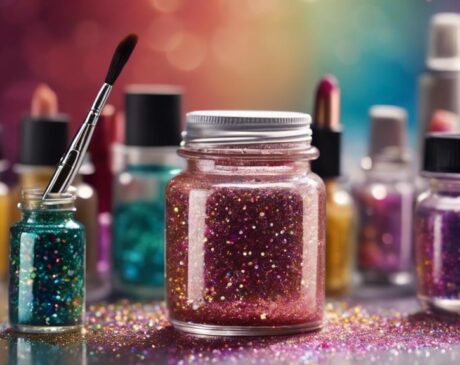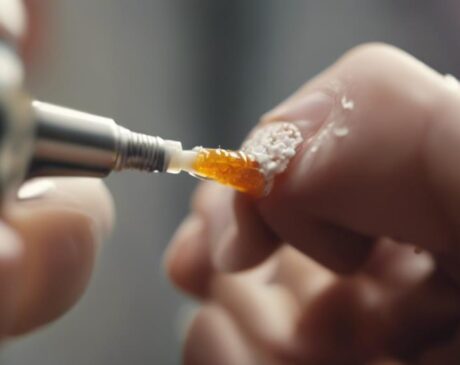Why Is My Fake Nail Hurting My Finger?
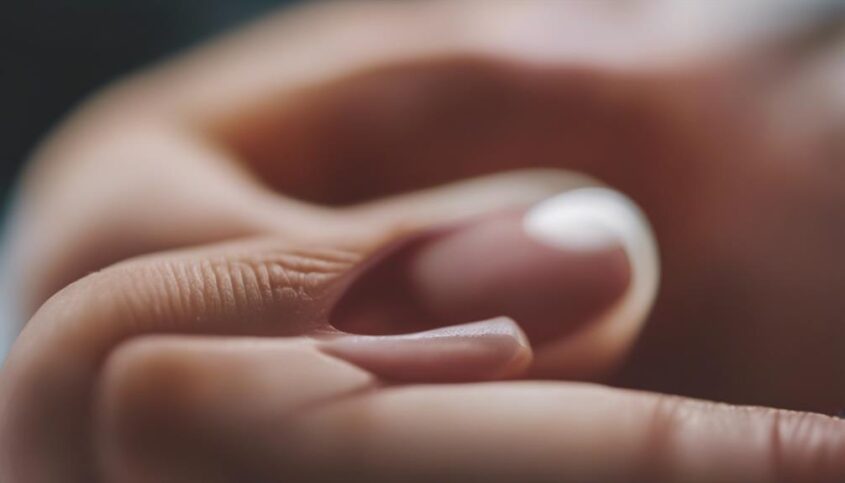
Discomfort from fake nails can stem from tightness, poor application, allergies, lifting, nail damage, or incorrect shaping. To prevent issues, maintain good hygiene, use breathable materials, and check nails regularly. Professional application and correct sizing are crucial, as is prompt treatment when problems arise. Keep nails smooth, moisturized, and avoid harsh chemicals. Seek innovative solutions and consult professionals when needed to support healthy nail enhancements. Ensure nails are trimmed properly and take breaks to prevent discomfort. Prioritize nail health to enjoy a pain-free experience. Further insight on nail care and solutions can help maintain healthy nails.
Key Takeaways
- Nail Is Too Tight: Tight nails can cause discomfort and pain by putting pressure on the nail bed.
- Improper Application: Incorrectly applied nails can lead to pain due to misalignment or excess pressure.
- Allergic Reactions: Some individuals may experience discomfort from allergic reactions to nail products used.
- Nail Lifting: Nails that lift or separate from the nail bed can cause pain and discomfort.
- Nail Length Issues: Incorrect length or shape can result in discomfort from pressure or snagging.
Nail Is Too Tight
In some cases, the discomfort experienced from a fake nail can be attributed to it being excessively tight on the natural nail bed. When a nail is too tight, it can put pressure on the surrounding skin and nail, leading to pain and discomfort. This issue often arises when the artificial nail is not properly sized or when the application process is rushed. As individuals seek innovative solutions for their nail enhancements, it is crucial to prioritize proper sizing and fitting techniques to prevent unnecessary discomfort.
Ensuring that the artificial nail fits correctly on the natural nail bed is essential for a comfortable and pain-free experience. Advancements in nail technology have provided tools and techniques to customize fake nails for each individual's unique nail shape and size. By embracing these innovative approaches, individuals can enjoy the benefits of fake nails without the associated discomfort caused by improper sizing or tightness. Prioritizing a proper fit not only enhances comfort but also promotes healthier nails in the long run.
Improper Nail Application
When fake nails are applied improperly, it can result in discomfort and potential harm to the natural nails and surrounding skin. Improper nail application can lead to a range of issues, including pain, nail damage, and even infections. To help you understand the common mistakes that can occur during nail application, let's explore some key factors to consider:
| Common Mistakes | Potential Harm | Prevention Strategies |
|---|---|---|
| Using too much glue | – Damage to natural nails | – Apply a thin layer of glue |
| Applying nails too close to the cuticle | – Risk of infection | – Leave a small gap between the nail and cuticle |
| Choosing the wrong nail size | – Discomfort and pain | – Measure nails properly before applying |
Allergic Reaction to Nail Products
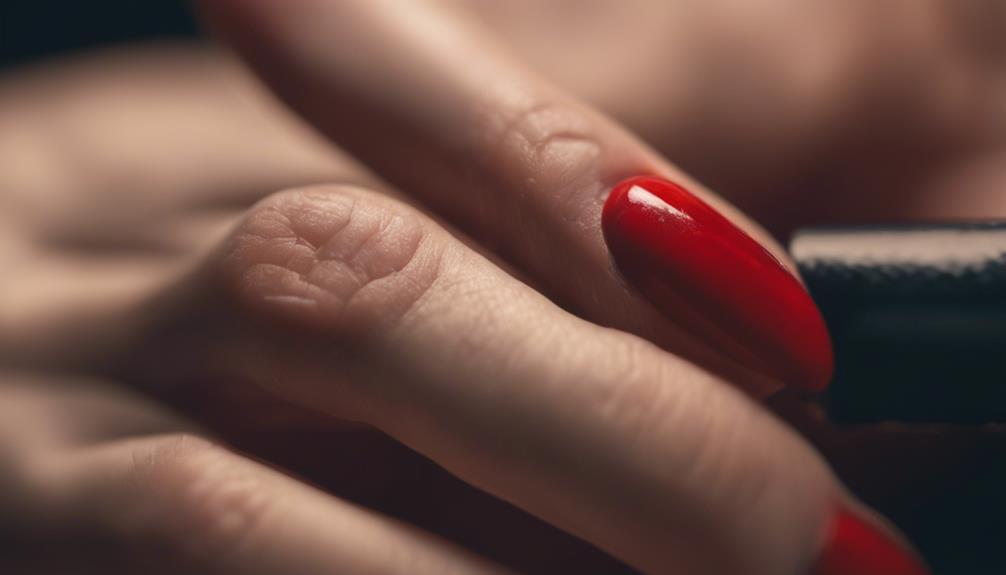
An adverse response to nail products can manifest as an allergic reaction, causing discomfort and potential skin issues for individuals wearing fake nails. Allergic reactions to nail products can range from mild irritation to more severe symptoms, impacting not only the nails but also the surrounding skin. Here are four key points to consider regarding allergic reactions to nail products:
- Ingredients: Nail products may contain allergens such as formaldehyde, toluene, and dibutyl phthalate, which can trigger allergic reactions in sensitive individuals.
- Symptoms: Allergic reactions to nail products can present as redness, itching, swelling, or even blistering around the nail area, indicating a negative response to the products used.
- Prevention: To prevent allergic reactions, individuals can opt for hypoallergenic nail products or undergo patch testing to identify specific allergens.
- Treatment: In the event of an allergic reaction, promptly removing the fake nails and using soothing creams or antihistamines can help alleviate discomfort and reduce skin irritation.
Nail Lifting or Separation
Nail lifting, also known as onycholysis, is a condition where the nail separates from the nail bed, potentially causing discomfort and cosmetic concerns. This phenomenon can occur due to various reasons, including trauma, fungal infections, or excessive exposure to moisture. In the realm of nail enhancements, nail lifting can also be triggered by improper application techniques or the use of low-quality products.
One innovative approach to addressing nail lifting involves the incorporation of breathable nail technologies. These advanced nail enhancements allow for better air and moisture circulation around the nail, reducing the likelihood of onycholysis. Additionally, proper nail care practices, such as avoiding excessive exposure to water and using reputable nail products, can help prevent nail lifting and promote overall nail health.
Nail Bed Damage
When fake nails cause damage to the nail bed, it can result in pain, inflammation, and increased sensitivity in the affected finger. The nail bed is a delicate area that can easily be injured by improper application or removal of fake nails. Understanding the signs of nail bed damage is crucial for preventing further discomfort and promoting proper healing.
Painful Nail Bed
Experiencing discomfort or pain in the nail bed can be indicative of various underlying issues that may require attention. When dealing with a painful nail bed, it's crucial to consider the following:
- Trauma: Any recent injury or trauma to the nail area can result in pain and discomfort in the nail bed.
- Infection: Bacterial or fungal infections can lead to inflammation and tenderness in the nail bed.
- Ingrown Nails: Ingrown nails occur when the nail grows into the surrounding skin, causing pain and potential infection.
- Allergic Reaction: Some individuals may experience a painful nail bed due to an allergic reaction to certain nail products or materials.
Understanding the root cause of the pain is essential in addressing and resolving the discomfort effectively.
Inflammation and Sensitivity
Damage to the nail bed resulting in inflammation and increased sensitivity can often be a manifestation of underlying issues that require careful examination and management. Inflammation, characterized by redness, swelling, and discomfort, may indicate trauma to the nail bed, leading to heightened sensitivity. This sensitivity can be exacerbated by the use of fake nails, causing further irritation and pain. It is crucial to address the root cause of the inflammation, which could be due to allergic reactions, infections, or improper nail application techniques. Seeking professional advice is essential to prevent long-term damage and ensure proper healing of the nail bed. By identifying and treating the underlying issues promptly, individuals can alleviate discomfort and maintain healthy nails.
Incorrect Nail Length or Shape
When fake nails are too long, they can cause discomfort and pressure on the nail bed, resulting in pain. Similarly, nails that are shaped incorrectly may press against the skin or adjacent nails, leading to irritation and soreness. Ensuring the proper length and shape of fake nails is essential to prevent unnecessary discomfort and potential damage to the natural nails.
Nail Length Issues
A common issue that can lead to discomfort when wearing fake nails is having an incorrect nail length or shape. When the nails are too long or extend past the fingertips, they can cause pressure and strain on the natural nail bed. Similarly, nails that are too short may not provide enough coverage or support, leading to an uneven distribution of pressure. To address nail length issues effectively, consider the following:
- Opt for a moderate length that allows for natural movement.
- Ensure the nails are trimmed to a length that aligns with the fingertips.
- Avoid excessively long nails that can hinder daily tasks.
- Experiment with different lengths to find the most comfortable option.
Shape Discomfort
Improper nail length or shape can result in discomfort and pain when wearing fake nails. If the nails are too long, they can press against the tips of your fingers, causing soreness and even making everyday tasks challenging. Conversely, nails that are too short may expose your natural nails, leading to sensitivity and potential damage. Additionally, an incorrect shape, such as sharp corners or overly curved tips, can dig into the skin, causing irritation and discomfort. To alleviate these issues, ensure that your fake nails are trimmed to an appropriate length and shaped in a way that follows the natural curve of your nail bed. Prioritizing comfort and proper fit will enhance your overall experience with fake nails.
Infection Under the Nail
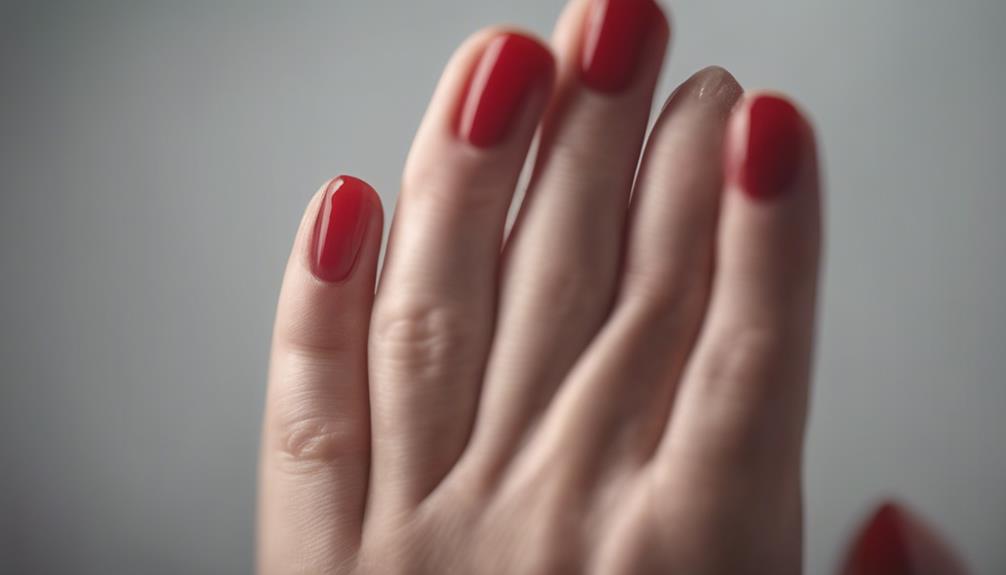
Underneath a fake nail, the presence of an infection can lead to discomfort and potential complications. While fake nails can enhance the aesthetics of your hands, improper application or maintenance can create an environment conducive to bacterial or fungal growth. Infections under fake nails can cause pain, swelling, redness, and even pus formation. Here are four innovative strategies to prevent and address infections under the nail:
- Proper Hygiene: Regularly clean and disinfect your nails to prevent the buildup of harmful bacteria.
- Breathable Materials: Opt for fake nails made from breathable materials to reduce the risk of moisture accumulation, which can promote infection.
- Regular Checks: Monitor your nails for any signs of infection, such as changes in color, texture, or sensitivity.
- Professional Application: Seek the expertise of a trained nail technician for the application and maintenance of fake nails to minimize the risk of infections due to improper techniques.
Frequently Asked Questions
Can Fake Nails Cause Long-Term Damage to My Natural Nails?
Fake nails can potentially harm your natural nails in the long run due to improper application or removal techniques. To maintain nail health, it's essential to use reputable products and seek professional assistance when needed.
How Can I Prevent Fake Nails From Causing Discomfort or Pain?
To prevent discomfort or pain from fake nails, ensure proper application by a trained professional, avoid excessive length or thickness, and opt for quality materials. Regular maintenance, moisturizing the natural nails, and giving them breaks between applications also help maintain nail health.
Are There Any Alternative Nail Enhancement Options That Are Less Likely to Cause Pain or Irritation?
Exploring alternative nail enhancement options can provide relief from discomfort or pain. Innovative solutions like gel nail extensions, dip powder nails, or natural nail strengthening treatments offer a variety of choices for individuals seeking a more comfortable experience.
Can I Still Wear Fake Nails if I Have Sensitive Skin or Allergies to Certain Nail Products?
For individuals with sensitive skin or allergies to certain nail products, exploring hypoallergenic nail options or consulting a dermatologist before applying fake nails can help mitigate potential discomfort. Prioritizing skin health while still enjoying nail enhancements is essential.
What Should I Do if My Fake Nail Starts to Hurt or Feel Uncomfortable After It Has Been Applied?
If a fake nail starts to hurt or feel uncomfortable post-application, consider potential causes like improper sizing or adhesive application. Prioritize nail health and seek professional guidance if discomfort persists to prevent further issues.

